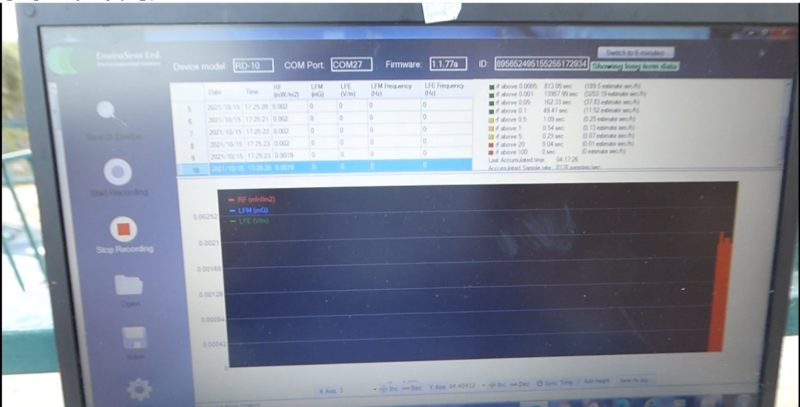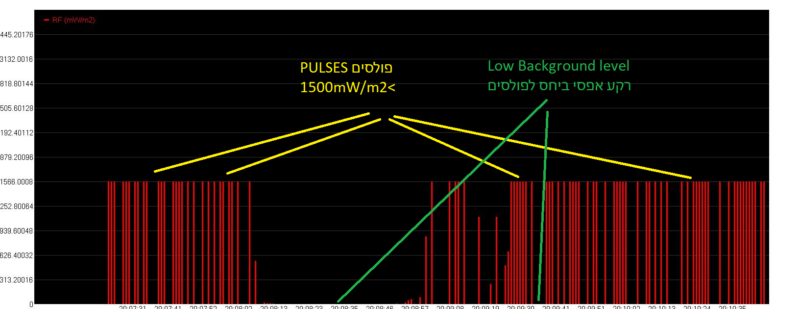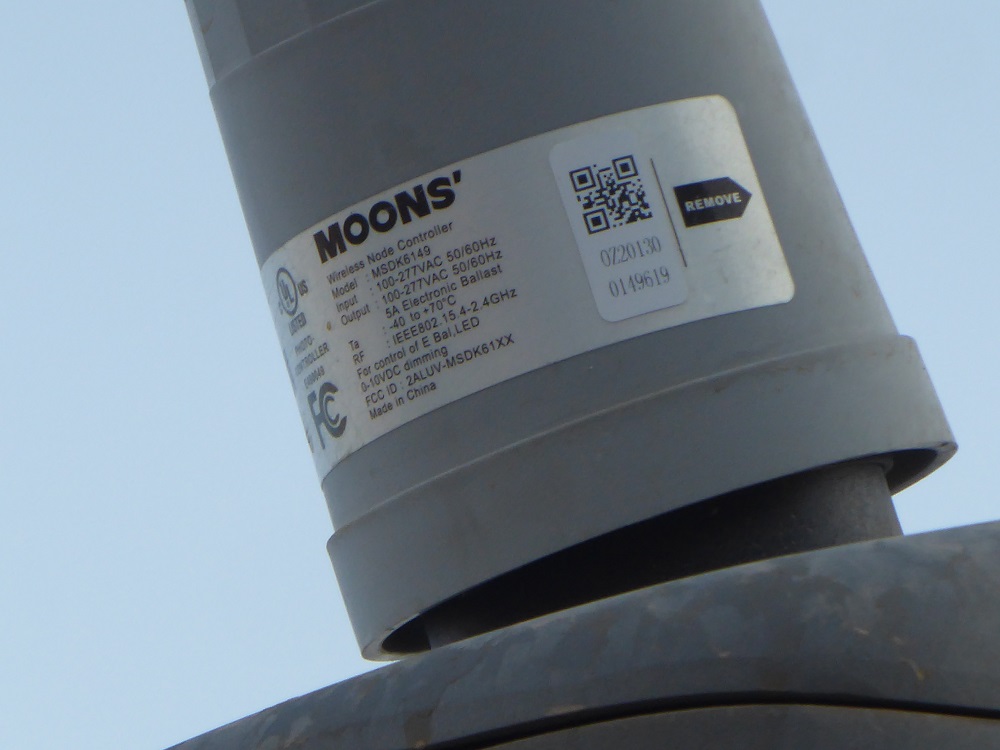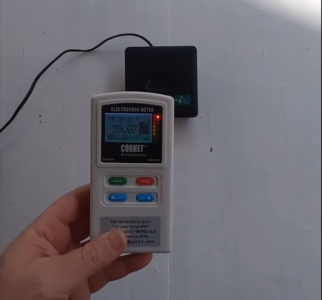Wireless street light poles started to be deployed in Israel around 2019. They are usually installed on a pole (high or low). On top of the new LED lights, there is a small “hat” which is the wireless transmitter.

Complaints without measurments
Since the deployment has started, I got several complaints from Electromagnetic Hyper Sensitive people. They all reported that they feel worse when these new wireless street lights are operating. But these complaints were not met with good RF measurements that show the RFR radiation admitted from the new street lights. I did got several measurements videos and pictures but In most cases, the person that did the measurements actually measured high background levels caused by a nearby cell tower, or by his own smartphone, and not the RFR radiation emitted by the wireless street light. This was the case until two weeks ago when I got the results of a good test. This test was done in low background levels, and clearly shows that these street lights emit RFR when they are ON.
Finally good measurements I can relay on
Two weeks ago I got detailed RFR measurements results, together with photos and video, and log files of the measurements.
The measurement was taken by a young man, that built the following setup:
1. The meter he used was the ENV RD10 (fast RFR home use meter),
2. The meter was connected to a laptop (with all transmissions turned OFF and with a special monitoring software) via a long USB cable.
3. The meter was put in a plastic cap(2) at the end of a long plastic tube(1).
4. Measurements were taken and recorded for a couple of minutes when the meter was located both next to the transmitter (3) and 2-3 meters away from it.



The results showed :
- RFR is emitted from the wireless street lights when they are ON, at night (and not during the day when they are OFF).
- The RFR is not “once in while” but a constant random burst of pulses, 1-2 seconds long, followed by a “down time” of few more seconds. In general you can say that out of 10 seconds, the signal was ON for 3-5 seconds.
- The Pulses are clearly above the low background (where it is a low background), even when measured 2-3 meters away from the transmitter.
- The RFR is similar in streanght to the RFR emitted from a wireless router.
- The RFR remind me a bit of the RFR emitted from wireless smartmash smart meters.
RF Radiation next to the transmitted during the day
During the day the streets lights did not get electricity and were not emitting any RFR.
The measurements results show only background radiation of up to 0.0354mW/m2.

RFR levels next to the Transmitter during the night
Next to the transmitter, during the night when the lights were ON, high RFR levels were measured (higher than 1500mW/m2). Much higher than the background levels during the day and night. Based on the levels during the day, and in between pulses, It was obvious that the source is the transmitter.
A clear pattern of the transmission was not clear, but I could say that there are about 3-5 seconds with pulses every 10 seconds. It seems like the transmitted is emitting RFR for 1-2 seconds and then resting for a few seconds.

RFR levels 2-3 meters bellow the transmitter
2-3 meters below the transmitter, the RFR pulses were still clear. Their level was between 0.2-0.6mW/m2. These levels are high enough to cause symptoms in EHS people.

Result summary
Not “Once a Day”
From these test results, it is clear the transmitter is emitting RFR all the time the light is ON, and not “Once a Day” as was suggested before. I could not see any clear pattern but it remind me of the way smart-mesh smart-meters emit RFR.
The transmission is clear above the background level
In contrary to past attempts to measure this, this time the transmission is clear above the low background level in this village. It is easy to see the difference between the pulses and the low background levels when the meter was next to the transmitter and also when it was 2-3 meters away.


The RFR reach the street level, and nearby houses, EHS people might be affected by it
The level that was measured 2-3 meters away from the transmitter is high enough to cause symptoms in some EHS people. EHS people that walk below these light poles or live right next to them (less than 5 meters) might be affected by this radiation. It is possible that at least part of the complaints I got in the past year about symptoms at night from these wireless street light pols, were caused by these wireless LED light poles.
Not Healty
Other than the possible effect this extra exposure might cause on EHS people, even that is low, this addition to the RFR exposure is not healthy for everyone. The deployment of these wireless LED street lights, will add more RFR to the environment. Try to imagine a small WIFI router on top of every one of these poles.
What can be done?
- Measure and see if RFR is entering your house from these wireless LED lights at night.
- Use RFR protection over the house.
- Ask the local autoroties for explanastion why there is a constant burst of puleses and not just one pules evey few minutes, hours, or twice a day.
- Ask the local autoroties if the transmitter on the wireless LED light close to your house, could be turned OFF.
- Take this into considuration when searching a new house to live in.
Test Protocol
- Find a low, easy to reach, wireless LED light, in an erea with a low RFR backgound.
- Don’t try to clime the pole.
- Don’t get close to electric wires.
- Don’t try to make this measurment unless you are preofessionals in the feild of electricity and electronics.
- You can use a plastic pole, or a wooden stick, with a plastic cap on the top, that will hold the meter.
- Use a fast RFR meter with USB connection (CORNET ED88TPLUS and ENV RD10 are sutiable).
Use the meters with a long USB cable, and a laptop (with all RFR turned OFF) that runs the monitoring softaware avialible on the meters products’ page. - Meassure the RFR Few meters from the wireless LED lights, or when it is not working, to get the referance background levels.
- Measure the RFR for about 20 seconds, when the meter is in diffrent distances from the wireless led light transmitter, right next to the transmitter, 50cm away from it, 1 meter, 2 meters, 5 meters.
- If you don’t have an easy and safe aproch to the transmitter, measure in the place you are, on the ground, in the window, on the porch, yeard and so on.
- Try to compeare the deferent measurments you took, to find a patern in the transmittion, if any, and see the levels of the pulses (if any). Try to identefy if the tranmitter on top of the LED light is actulay transmitting, when, for how log, how strong and how far the RFR is still noticialbe.
Video explanation
Link – https://youtu.be/BUDRice5zyc




